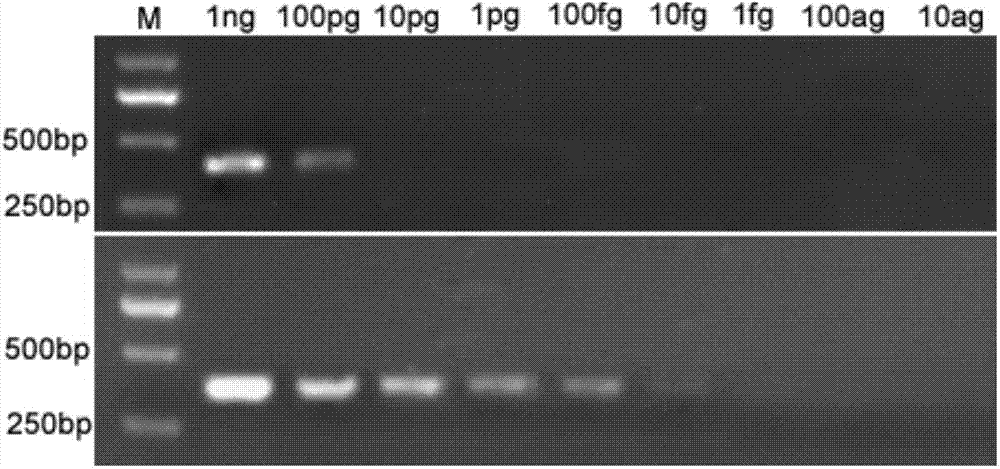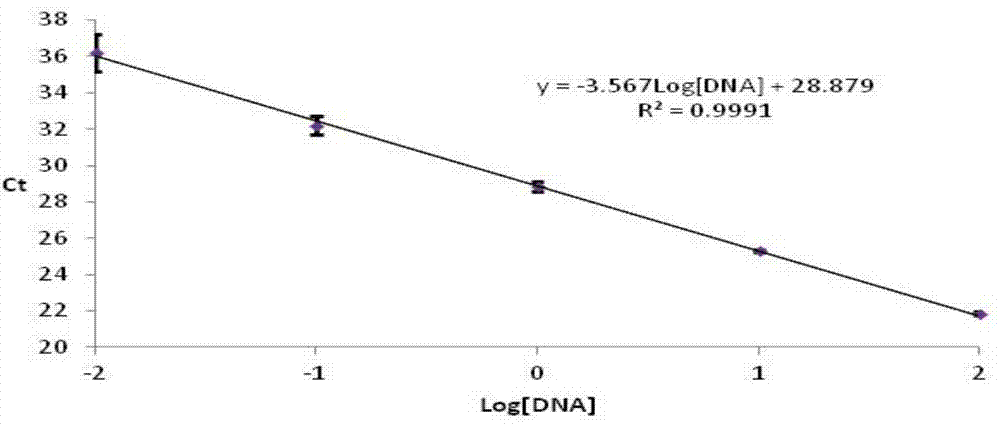Molecular detection primer specific for phytophthora sojae and application thereof
A technology for molecular detection and Phytophthora sojae, applied in the biological field, can solve the problems of distinguishing, unsuitable for quantitative detection methods, etc., and achieve the effect of high specificity and sensitivity
- Summary
- Abstract
- Description
- Claims
- Application Information
AI Technical Summary
Problems solved by technology
Method used
Image
Examples
Embodiment 1
[0028] Detection results of soybean susceptible plants:
[0029] 1) DNA extraction of diseased plants: Disinfect soybean leaves or rhizomes with water-soaked lesions with 70% alcohol, grind them with liquid nitrogen, take a small amount of powder, and use CTAB method to extract genome. Alkaline lysis can also be used to quickly extract DNA. The method is as follows: Take a section of diseased plant tissue, add 10 μl 0.5 M NaOH per mg of tissue, grind it thoroughly, transfer it to a 1.5 ml EP tube, centrifuge at 12,000 rpm for 5 minutes, and take 1 μl was directly used for PCR amplification.
[0030] 2) Ordinary PCR amplification verification: take 1 μl of DNA solution as a reaction template, use the Phytophthora soybean specific base sequence PsYkt6-F / PsYkt6-R as primers, and perform PCR amplification with the reagents and dosages mentioned above, Take 10 μl of the amplified product for gel electrophoresis detection. The results show that the diseased plants can amplify spe...
Embodiment 2
[0033] The detection results of residual Phytophthora soybean oospores in the soil:
[0034] 1) Extraction of microbial DNA in soil: Each soil sample was dried and crushed, then 0.5g of soil sample was weighed, and DNA was extracted using FastDNA SPIN kit (Q-Biogene Ltd, USA).
[0035] 2) Ordinary PCR amplification verification: Take 1 μL of DNA solution as a reaction template, use the PsYkt6-F / PsYkt6-R primers specific to Phytophthora sojae and the Ykt6 Phytophthora general primers Ykt6F / Ykt6R in a complete set of the present invention. PCR was used to amplify, and 10 μL of the amplified product was used for gel electrophoresis detection. The results showed that among the 14 soils collected from soybean fields in different regions, 11 could detect the target band, indicating that there were eggs of Phytophthora sojae. Spores, the artificial inoculation of the soil containing Phytophthora sojae oospores can also amplify the target band, but no band is amplified in the negat...
Embodiment 3
[0038] Detection results of zoospores in water sources polluted by Phytophthora sojae:
[0039] 1) Zoospore enrichment and DNA extraction: Phytophthora sojae can form sporangia and release a large number of zoospores in an environment with a water film, which is an important way for re-infection. Take 500 mL of water source contaminated by Phytophthora sojae, centrifuge it at 5000 g for 20 min, pour off the supernatant, suspend the precipitated zoospores with 100 μL of water, transfer to a 1.5 mL centrifuge tube, add 0.05 g of quartz sand, and vortex for 10 seconds After centrifugation at 2000rpm for 5 minutes, the supernatant was taken for PCR amplification.
[0040] 2) Ordinary PCR amplification verification: take 1 μL zoospore supernatant as a reaction template, and use the PsYkt6-F / PsYkt6-R primers specific to Phytophthora sojae and Ykt6 Phytophthora general primers Ykt6F / Ykt6R of the present invention as a complete set Using nested PCR for amplification, 10 μL of the a...
PUM
 Login to View More
Login to View More Abstract
Description
Claims
Application Information
 Login to View More
Login to View More - R&D
- Intellectual Property
- Life Sciences
- Materials
- Tech Scout
- Unparalleled Data Quality
- Higher Quality Content
- 60% Fewer Hallucinations
Browse by: Latest US Patents, China's latest patents, Technical Efficacy Thesaurus, Application Domain, Technology Topic, Popular Technical Reports.
© 2025 PatSnap. All rights reserved.Legal|Privacy policy|Modern Slavery Act Transparency Statement|Sitemap|About US| Contact US: help@patsnap.com



